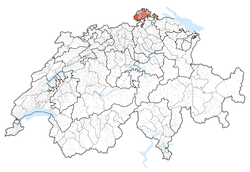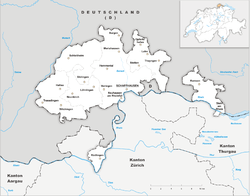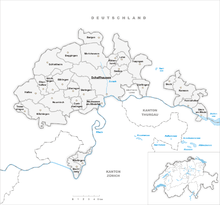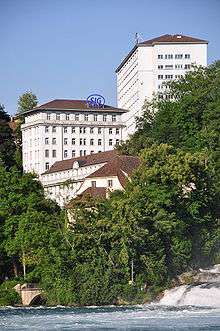Canton of Schaffhausen
| Kanton Schaffhausen | ||
|---|---|---|
| Canton of Switzerland | ||
| ||
 Location in Switzerland | ||
|
Map of Schaffhausen  | ||
| Coordinates: 47°43′N 8°34′E / 47.717°N 8.567°ECoordinates: 47°43′N 8°34′E / 47.717°N 8.567°E | ||
| Capital | Schaffhausen | |
| Subdivisions | 27 municipalities | |
| Government | ||
| • Executive | Regierungsrat (5) | |
| • Legislative | Kantonsrat (60) | |
| Area[1] | ||
| • Total | 298.42 km2 (115.22 sq mi) | |
| Population (12/2015)[2] | ||
| • Total | 79,836 | |
| • Density | 270/km2 (690/sq mi) | |
| ISO 3166 code | CH-SH | |
| Highest point | 912 m (2,992 ft): Hoher Randen | |
| Lowest point | 344 m (1,129 ft): Rhine at Buchberg | |
| Joined | 1501 | |
| Languages | German | |
| Website | SH.ch | |
The Canton of Schaffhausen (German: ![]() Schaffhausen ) is a canton of Switzerland. The principal city and capital of the canton is Schaffhausen.
Schaffhausen ) is a canton of Switzerland. The principal city and capital of the canton is Schaffhausen.
History
Schaffhausen was a city-state in the Middle Ages; it is documented that it struck its own coins starting in 1045. It was then documented as Villa Scafhusun.[3] Around 1049 Count Eberhard von Nellenburg founded a Benedictine monastery which led to the development of a community. This community achieved independence in 1190. In 1330 the town lost not only all its lands but also its independence to the Habsburgs. In 1415 the Habsburg Duke Frederick IV of Austria sided with the Antipope John XXIII at the Council of Constance, and was banned by the Emperor Sigismund. As a result of the ban and Frederick's need of money, Schaffhausen was able to buy its independence from the Habsburgs in 1418. The city allied with six of the Swiss confederates in 1454 and allied with a further two (Uri and Unterwalden) in 1479. Schaffhausen became a full member of the Old Swiss Confederation in 1501.[3] The first railroad came to Schaffhausen in 1857. In 1944 Schaffhausen suffered from a bombing raid by United States Army Air Forces planes that accidentally strayed from Germany into neutral Switzerland.
The cantonal constitution was written in 1876 and revised in 1895.
The distinctive coat of arms bears the Schaffhauser Bock (billy goat of Schaffhausen).
Geography
Schaffhausen is the northernmost canton of Switzerland and lies almost entirely on the right bank of the Rhine, with only part of Stein am Rhein on the left bank. It lies west of Lake Constance and has an area of 298 km2 (115 sq mi).[4] Much of the canton is productive agricultural land, with 134.4 km2 (51.9 sq mi) (about 45%) of the canton used for agriculture while an additional 128.7 km2 (49.7 sq mi) (about 43%) is wooded. Most of the rest of the canton, 31.8 km2 (12.3 sq mi) (about 10%), is developed, while only 3.8 km2 (1.5 sq mi) (1.3%) of the canton is unproductive (rivers, lakes or mountains).[5]
The canton's territory is divided into three non-contiguous segments where German territory reaches the Rhine. The large central part, which includes the capital Schaffhausen, in turn separates the German exclave of Büsingen am Hochrhein from the rest of Germany. The small exclave of Rüdlingen-Buchberg lies to the southwest, and the third part contains Ramsen and Stein am Rhein to the east. With the exception of Vor der Brugg, part of Stein am Rhein, all three segments are separated from the rest of Switzerland by the Rhine.
The canton of Schaffhausen is bordered by the Swiss cantons of Zurich and Thurgau, as well as the German districts of Waldshut, Schwarzwald-Baar-Kreis and Konstanz, Baden-Württemberg.
Most of the canton lies on a plateau dominated by the Hoher Randen. The summit of this mountain is at 912 m (2,992 ft). The slopes of the mountain are gentle towards the south where it reaches the Rhine valley. Short and narrow valleys intersect these gentle slopes. The Klettgau is one such valley.
The Rhine Falls are the largest waterfalls in Europe and lie on the border of the cantons of Schaffhausen and Zürich.
Municipalities

There are 27 municipalities in the canton as of January 2009.[6]
Demographics
The population of the canton (as of 31 December 2015) is 79,836.[7] As of 2007, the population included 16,323 foreigners, or about 21.9% of the total population.[8] The German language and Protestant faith predominate. The majority of the population (as of 2000) is Protestant (50%) while a large minority is Roman Catholic (24%).[9]
| Year | 1850 | 1880 | 1900 | 1950 | 1970 | 2000 |
|---|---|---|---|---|---|---|
| Population | 35 300 | 38 241 | 41 514 | 57 515 | 72 854 | 73 392 |
| Language | ||||||
| German | 38 117 | 40 290 | 55 257 | 61 518 | 64 323 | |
| Italian | 39 | 886 | 1 490 | 6 682 | 1 897 | |
| French | 149 | 264 | 529 | 553 | 370 | |
| Romansch | 4 | 16 | 101 | 139 | 80 | |
| Other | 39 | 58 | 138 | 3 962 | 6 722 | |
| Religion | ||||||
| Protestant | 33 880 | 33 897 | 34 046 | 44 408 | 46 772 | 37 025 |
| Catholic | 1 411 | 4 154 | 7 403 | 12 431 | 23 277 | 17 790 |
| Chr. Catholic | 275 | 192 | 83 | |||
| Other | 9 | 297 | 65 | 401 | 2 613 | 18 494 |
| Nationality | ||||||
| Swiss | 33 938 | 33 963 | 33 860 | 53 950 | 58 907 | 58 290 |
| Other | 1 362 | 4 278 | 7 654 | 3 565 | 13 947 | 15 102 |
Politics
Cantonal government
The legislature is the Cantonal Council (Kantonsrat) of Schaffhausen, which consists of 60 members elected proportionally every four years. Until 2008, it consisted of 80 members.
The executive branch is the Government Council (Regierungsrat), which consists of 5 members elected every four years.
Federal election results
| Percentage of the total vote per party in the canton in the Federal Elections 1971-2015[11] | ||||||||||||||
|---|---|---|---|---|---|---|---|---|---|---|---|---|---|---|
| Party | Ideology | 1971 | 1975 | 1979 | 1983 | 1987 | 1991 | 1995 | 1999 | 2003 | 2007 | 2011 | 2015 | |
| FDP.The Liberalsa | Classical liberalism | 33.1 | 40.1 | 32.3 | 26.2 | 34.3 | 28.6 | 31.9 | 40.4 | 29.1 | 26.7 | 12.3 | 12.9 | |
| CVP/PDC/PPD/PCD | Christian democracy | 8.0 | * b | * | 6.3 | * | * | * | * | 2.7 | * | 5.2 | * | |
| SP/PS | Social democracy | 40.2 | 37.2 | 35.3 | 35.4 | 39.2 | 34.2 | 37.8 | 33.6 | 39.7 | 34.2 | 34.6 | 28.8 | |
| SVP/UDC | Swiss nationalism | * | * | 21.1 | 22.6 | 23.5 | 19.2 | 20.4 | 26.0 | 28.5 | 39.1 | 39.9 | 45.3 | |
| Ring of Independents | Social liberalism | 12.2 | 16.6 | * | 5.6 | * | * | * | * | * | * | * | * | |
| EVP/PEV | Christian democracy | * | * | 6.3 | * | * | * | * | * | * | * | * | * | |
| POCH | Progressivism | * | 6.1 | 4.1 | 2.7 | * | * | * | * | * | * | * | * | |
| GPS/PES | Green politics | * | * | * | * | * | * | * | * | * | * | * | 3.4 | |
| FGA | Feminist | * | * | * | * | * | 3.9 | * | * | * | * | * | * | |
| SD/DS | National conservatism | 6.4 | * | * | * | * | * | * | * | * | * | * | * | |
| EDU/UDF | Christian right | * | * | * | * | 3.0 | 2.7 | * | * | * | * | 3.8 | 5.1 | |
| FPS/PSL | Right-wing populism | * | * | * | * | * | 11.4 | 8.6 | * | * | * | * | * | |
| Other | * | * | 0.9 | 1.2 | * | * | 1.4 | * | * | * | 4.3 | 4.4 | ||
| Voter participation % | 78.7 | 74.1 | 75.1 | 73.7 | 69.6 | 69.0 | 64.4 | 61.9 | 63.2 | 65.3 | 60.8 | 62.6 | ||
- ^a FDP before 2009, FDP.The Liberals after 2009
- ^b "*" indicates that the party was not on the ballot in this canton.
Economy

Schaffhausen is a part of the Zürcher Wirtschaftsraum (Zurich economic region) and the canton's economy is well integrated with that of the wider region.
Well-regarded white Riesling wine is grown here as well as several other varieties.[12] The main industries, however, are the production of machinery and metal goods. There is also watch making and jewellery. Minor industrial branches are textiles, leather goods, glass, cement, paper and chemicals.[13] There is a brewery in the canton.
At Rheinau there is a hydro electrical power plant generating electricity for the canton and for export. Major electricity customers are the chemical industry in Rheinfelden and the aluminium plant at Neuhausen am Rheinfall. The city of Schaffhausen also uses much of the electricity produced at Rheinau.
Schaffhausen lies on the busy Milan-Zurich-Stuttgart rail line which is serviced by trains from both the Swiss Federal Railways and German Railways.[14]
The largest companies are Tyco International, Tyco Electronics, SIG, Georg Fischer AG, International Watch Company and Cilag AG.
Notes and references
- ↑ Arealstatistik Standard - Kantonsdaten nach 4 Hauptbereichen
- ↑ Swiss Federal Statistical Office - STAT-TAB, online database – Ständige und nichtständige Wohnbevölkerung nach institutionellen Gliederungen, Geburtsort und Staatsangehörigkeit (German) accessed 30 August 2016
- 1 2 "Schaffhausen (city)". Encyclopædia Britannica. 24. 1911. p. 312. Retrieved 2009-04-18.
- ↑ Canton Schaffhausen website, Geography (German). Retrieved 18 April 2009
- ↑ Federal Department of Statistics (2008). "Arealstatistik – Kantonsdaten nach 15 Nutzungsarten" (Microsoft Excel). Retrieved 2009-01-15.(German)
- ↑ "Répertoire officiel des communes de Suisse". Statistique Suisse. 1 January 2009. Retrieved 10 July 2009.
- ↑ Swiss Federal Statistical Office - STAT-TAB, online database – Ständige und nichtständige Wohnbevölkerung nach institutionellen Gliederungen, Geburtsort und Staatsangehörigkeit (German) accessed 30 August 2016
- ↑ Federal Department of Statistics (2008). "Ständige Wohnbevölkerung nach Staatsangehörigkeit, Geschlecht und Kantonen" (Microsoft Excel). Retrieved 5 November 2008.
- ↑ Federal Department of Statistics (2004). "Wohnbevölkerung nach Religion" (Interactive Map). Retrieved 2009-01-15.
- ↑ http://www.hls-dhs-dss.ch/textes/d/D7388.php
- ↑ Nationalratswahlen: Stärke der Parteien nach Kantonen (Schweiz = 100%) (Report). Swiss Federal Statistical Office. 2015.
- ↑ Canton Schaffhausen website, Wine Production (German). Retrieved 18 April 2009
- ↑ Canton Schaffhausen website- Economic Promotion. Retrieved 18 April 2009
- ↑ "Economic Promotion: Canton Schaffhausen: Geographic Location". Canton Schaffhausen. Archived from the original on 23 September 2009. Retrieved 6 January 2015.
External links
| Wikimedia Commons has media related to Canton of Schaffhausen. |
- Official site (German)
- Archives (German)
- Official statistics
